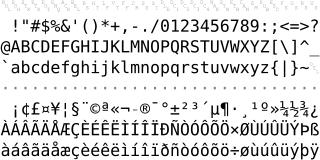
Character encoding is the process of assigning numbers to graphical characters, especially the written characters of human language, allowing them to be stored, transmitted, and transformed using digital computers. The numerical values that make up a character encoding are known as "code points" and collectively comprise a "code space", a "code page", or a "character map".
Extended Binary Coded Decimal Interchange Code is an eight-bit character encoding used mainly on IBM mainframe and IBM midrange computer operating systems. It descended from the code used with punched cards and the corresponding six-bit binary-coded decimal code used with most of IBM's computer peripherals of the late 1950s and early 1960s. It is supported by various non-IBM platforms, such as Fujitsu-Siemens' BS2000/OSD, OS-IV, MSP, and MSP-EX, the SDS Sigma series, Unisys VS/9, Unisys MCP and ICL VME.

ISO/IEC 8859-1:1998, Information technology — 8-bit single-byte coded graphic character sets — Part 1: Latin alphabet No. 1, is part of the ISO/IEC 8859 series of ASCII-based standard character encodings, first edition published in 1987. ISO/IEC 8859-1 encodes what it refers to as "Latin alphabet no. 1", consisting of 191 characters from the Latin script. This character-encoding scheme is used throughout the Americas, Western Europe, Oceania, and much of Africa. It is the basis for some popular 8-bit character sets and the first two blocks of characters in Unicode.

Windows-1252 or CP-1252 is a single-byte character encoding of the Latin alphabet that was used by default in Microsoft Windows for English and many Romance and Germanic languages including Spanish, Portuguese, French, and German. This character-encoding scheme is used throughout the Americas, Western Europe, Oceania, and much of Africa.
The yen and yuan sign (¥) is a currency sign used for the Japanese yen and the Chinese yuan currencies when writing in Latin scripts. This character resembles a capital letter Y with a single or double horizontal stroke. The symbol is usually placed before the value it represents, for example: ¥50, or JP¥50 and CN¥50 when disambiguation is needed. When writing in Japanese and Chinese, the Japanese kanji and Chinese character is written following the amount, for example 50円 in Japan, and 50元 or 50圆 in China.
ISO/IEC 8859-2:1999, Information technology — 8-bit single-byte coded graphic character sets — Part 2: Latin alphabet No. 2, is part of the ISO/IEC 8859 series of ASCII-based standard character encodings, first edition published in 1987. It is informally referred to as "Latin-2". It is generally intended for Central or "Eastern European" languages that are written in the Latin script. Note that ISO/IEC 8859-2 is very different from code page 852 which is also referred to as "Latin-2" in Czech and Slovak regions. Code page 912 is an extension. Almost half the use of the encoding is for Polish, and it's the main legacy encoding for Polish, while virtually all use of it has been replaced by UTF-8.
ISO/IEC 8859-11:2001, Information technology — 8-bit single-byte coded graphic character sets — Part 11: Latin/Thai alphabet, is part of the ISO/IEC 8859 series of ASCII-based standard character encodings, first edition published in 2001. It is informally referred to as Latin/Thai. It is nearly identical to the national Thai standard TIS-620 (1990). The sole difference is that ISO/IEC 8859-11 allocates non-breaking space to code 0xA0, while TIS-620 leaves it undefined.
ISO/IEC 8859-8, Information technology — 8-bit single-byte coded graphic character sets — Part 8: Latin/Hebrew alphabet, is part of the ISO/IEC 8859 series of ASCII-based standard character encodings. ISO/IEC 8859-8:1999 from 1999 represents its second and current revision, preceded by the first edition ISO/IEC 8859-8:1988 in 1988. It is informally referred to as Latin/Hebrew. ISO/IEC 8859-8 covers all the Hebrew letters, but no Hebrew vowel signs. IBM assigned code page 916 to it. This character set was also adopted by Israeli Standard SI1311:2002, with some extensions.

The pound sign is the symbol for the pound unit of sterling – the currency of the United Kingdom and its associated Crown Dependencies and British Overseas Territories and previously of Great Britain and of the Kingdom of England. The same symbol is used for other currencies called pound, such as the Egyptian and Syrian pounds. The sign may be drawn with one or two bars depending on personal preference, but the Bank of England has used the one-bar style exclusively on banknotes since 1975.
ISO/IEC 8859-4:1998, Information technology — 8-bit single-byte coded graphic character sets — Part 4: Latin alphabet No. 4, is part of the ISO/IEC 8859 series of ASCII-based standard character encodings, first edition published in 1988. It is informally referred to as Latin-4 or North European. It was designed to cover Estonian, Latvian, Lithuanian, Greenlandic, and Sámi. It has been largely superseded by ISO/IEC 8859-10 and Unicode. Microsoft has assigned code page 28594 a.k.a. Windows-28594 to ISO-8859-4 in Windows. IBM has assigned code page 914 to ISO 8859-4.
ISO/IEC 8859-6:1999, Information technology — 8-bit single-byte coded graphic character sets — Part 6: Latin/Arabic alphabet, is part of the ISO/IEC 8859 series of ASCII-based standard character encodings, first edition published in 1987. It is informally referred to as Latin/Arabic. It was designed to cover Arabic. Only nominal letters are encoded, no preshaped forms of the letters, so shaping processing is required for display. It does not include the extra letters needed to write most Arabic-script languages other than Arabic itself.
ISO/IEC 8859-7:2003, Information technology — 8-bit single-byte coded graphic character sets — Part 7: Latin/Greek alphabet, is part of the ISO/IEC 8859 series of ASCII-based standard character encodings, first edition published in 1987. It is informally referred to as Latin/Greek. It was designed to cover the modern Greek language. The original 1987 version of the standard had the same character assignments as the Greek national standard ELOT 928, published in 1986. The table in this article shows the updated 2003 version which adds three characters. Microsoft has assigned code page 28597 a.k.a. Windows-28597 to ISO-8859-7 in Windows. IBM has assigned code page 813 to ISO 8859-7. (IBM CCSID 813 is the original encoding. CCSID 4909 adds the euro sign. CCSID 9005 further adds the drachma sign and ypogegrammeni.)

Code page 850 is a code page used under DOS operating systems in Western Europe. Depending on the country setting and system configuration, code page 850 is the primary code page and default OEM code page in many countries, including various English-speaking locales, whilst other English-speaking locales default to the hardware code page 437.

Code page 437 is the character set of the original IBM PC. It is also known as CP437, OEM-US, OEM 437, PC-8, or DOS Latin US. The set includes all printable ASCII characters as well as some accented letters (diacritics), Greek letters, icons, and line-drawing symbols. It is sometimes referred to as the "OEM font" or "high ASCII", or as "extended ASCII".
Code page 852 is a code page used under DOS to write Central European languages that use Latin script.
The currency sign¤ is a character used to denote an unspecified currency. It can be described as a circle the size of a lowercase character with four short radiating arms at 45° (NE), 135° (SE), 225° (SW) and 315° (NW). It is raised slightly above the baseline. The character is sometimes called scarab.
Several 8-bit character sets (encodings) were designed for binary representation of common Western European languages, which use the Latin alphabet, a few additional letters and ones with precomposed diacritics, some punctuation, and various symbols. These character sets also happen to support many other languages such as Malay, Swahili, and Classical Latin.
Windows code pages are sets of characters or code pages used in Microsoft Windows from the 1980s and 1990s. Windows code pages were gradually superseded when Unicode was implemented in Windows, although they are still supported both within Windows and other platforms, and still apply when Alt code shortcuts are used.

Extended ASCII is a repertoire of character encodings that include the original 96 ASCII character set, plus up to 128 additional characters. There is no formal definition of "extended ASCII", and even use of the term is sometimes criticized, because it can be mistakenly interpreted to mean that the American National Standards Institute (ANSI) had updated its ANSI X3.4-1986 standard to include more characters, or that the term identifies a single unambiguous encoding, neither of which is the case.
Several mutually incompatible versions of the Extended Binary Coded Decimal Interchange Code (EBCDIC) have been used to represent the Japanese language on computers, including variants defined by Hitachi, Fujitsu, IBM and others. Some are variable-width encodings, employing locking shift codes to switch between single-byte and double-byte modes. Unlike other EBCDIC locales, the lowercase basic Latin letters are often not preserved in their usual locations.







